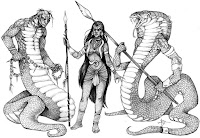D&D has traditionally segregated dragons into a variety of arbitrary categories and devised pseudo-naturalistic explanations for them. I have decided to just ignore all that in favor of treating dragons as dragons. Take the statistics in the MM and reskin the dragon however you need to. They don't need to be a natural species with a place in the ecology. Every dragon could be unique!
A collection of my ramblings on fantasy physics, game mechanics, and planar adventures as they apply to Dungeons and Dragons and its retroclones.
Monday, July 31, 2017
Monday, July 24, 2017
Ecology of serpentfolk
Yuan-ti and sarrukh are not open game content, so I will be replacing them with a generic saurian and serpentfolk race.
 |
| © Beth Trott |
Nomenclature: illujan, inphidian, nagaji, ophidokolasis, ophiduan, reptoid, samat, scalrath, serpentfolk, viskanya, etc
Description: squamous humanoids descended from lost empire, prone to mutation and crossbreeding
Description: squamous humanoids descended from lost empire, prone to mutation and crossbreeding
Thursday, July 20, 2017
"Cecaelia" isn't a word and you should stop using it
Pathfinder labels the octopus mermaid as a "cecaelia." This isn't a real word, so you can be forgiven for thinking Paizo made it up. In fact, it originates from a wikipedia article posted in 2008 which has since been deleted for being a meaningless neologism. In all likelihood, "cecaelia" is a misspelling of the feminine given name Cecilia or the amphibian order of Caecilians. Both words are derived from the Latin word for "blind" and have nothing to do with octopuses, mermaids, or octopus mermaids. UPDATED 12/4/2018 8/17/2023 4/25/2025
Subscribe to:
Comments (Atom)